Humphry Repton's Landscape Plans For Hanslope Park |
 |
Humphry Repton (1752 - 1818) visited Edward Watts Esq. at Hanslope Park in 1791 to produce plans and sketches for landscaping the grounds of Hanslope Park. He had produced the "Red Book" containing his ideas and plans by January 1792. | |||||||||
|
The following is Repton's introduction to his book.
Sir
In the following pages I shall in a more lasting manner than by mere conversation, explain my ideas on the improvement of Hanslope Park. I must observe however that this small volume can only describe the general outline of the plan which I recommend, together with some reasons for my opinion; neither the Map nor drawings on so small a scale, can be deemed sufficiently accurate to preclude the necessity of marking the detail with more precision on the spot: indeed some parts of what I now suggest, have already been executed; and in those instances the remarks become a record of what has been done, and not a guide for its performance.
Repton's Plan for Hanslope Park
|
||||||||||
|
In the "Red Book" Repton wrote three pages on his thoughts and ideas about Hanslope Park. Click here to see these pages. |
||||||||||
|
Situation |
||||||||||
| It is sometimes a misfortune to a place, that it is situated in the neighbourhood of one more beautiful, and perhaps it is partly to the vicinity of Gayhurst* that Hanslope has been neglected till it had acquired the reputation of being
..................................................."such an inauspicious spot "As bears no trace of beauty." .............................................. I must answer for it in the words of my Poetic Guide "Believe the Muse "She does not know that inauspicious spot Thus it is at Hanslope, we have not to wait the tedious growth of distant hanging woods to enrich the Landscape, but we must appropriate those woods to the Mansion: at present they are in part divided from it by corn fields, for altho' as shown in the foregoing sketch it is only in the corner of the scene that these fields present themselves, yet in the imagination always apt to increase its disgusts, as well as to magnify its pleasures, will suppose the same line of corn fields occupying all the ground that falls from the eye betwixt the Lawn and the opposite hills, especially as the strait Glade or riding cut in the wood gives it rather the appearance of being Crown=land, than private property; because we are now more used to see strait ridings cut thro' forests than in the woods belonging to a park: to remedy this, I have shown the effect of opening this wood, and have supposed a white cottage or keepers lodge so situated as to lead the eye immediately to that feature, which ought by every artifice to be rendered as conspicuous as possible without betraying too much the interference of Art. * For further information about Repton's connection with Gayhurst, click here |
||||||||||
|
In Repton`s Red Book he included watercolours of the view as it was, with a flap that folded down showing his proposed changes. The original view is below followed by his proposed view. |
||||||||||
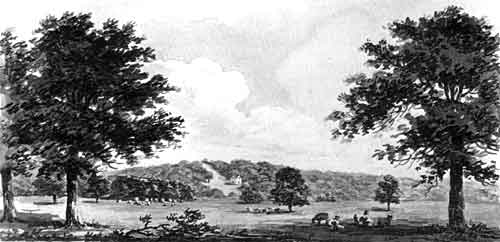 |
||||||||||
|
Approaches |
||||||||||
|
There is no part of the Art I profess so essential, as that of making the Approach to a place convenient; and yet to display its best features to advantage, without unnecessarily departing from the nearest line to the house for the purpose of showing them. It is not within the Lawn only that an approach should be considered, every road near the house should also be made accessible. The plantation marked on the ground to encompass and hide the Garden and Offices, will throw the approach from the village of Hanslope in such a direction as to display the large wood in the most favourable point of view, but the Lawn to the north being rather flat and uninteresting, I think that it might be shorten'd without injury as I have shown on the map by the cross fence A, A, which must be covered by plantations, and the ground thus taken from the lawn may be either converted to a separate pasture or plowed up in addition to the farm. The Approach from Gayhurst may be made more interesting and important by leading it thro' that skreen of plantation which I have shown on the map at B, B, but as I have availed myself of the present hedge for one fence to this plantation, it will be proper to make a clump at C to break the too long continued strait line; it is to avoid the continuance of this same line that I propose the shapes of the plantations at D, D, which will then not appear so small as they really are, when first seen at the spot where the approach quits the plantation; a spot, from whence the house itself looks much better than in any other point of view. |
||||||||||
 |
||||||||||
|
Avenues |
||||||||||
| I have already had so many occasions to consider the treatment of Avenues* that I may transcribe from one of them the following enquiry into the causes of approbation or disgust which we so frequently hear expressed on the sight of Avenues; being part of a more ample discussion on the subject. "The several species of pleasure which the mind derives from the love of order, of, "Unity, of Antiquity, of greatness and continuity, are all in some degree excited by the long perspective view of a stately Avenue: this is evident from the sensations which every one must recollect to have felt when a Child, on the first sight of any magnificent avenue such as those at Windsor, at Hatfield, or Burleigh etc; but the eye soon becomes wearied with the dull repetition of equi-distant trees however venerable in themselves; besides all novelty or diversity of situation is totally precluded by surrounding a house with Avenues, since the view from every seat in the Kingdom would be nearly reduced to the same Landscape, if looking along a strait line betwixt two rows of trees can deserve to be called a Landscape". Yet the Avenues at Hanslope afford almost all the large trees from we at first can hope for shade. Convenience therefore forbids us to cut down many of the trees merely because the false taste of former times has planted them in rows, at least till those plantations which are now proposed, shall better replace the shelter which the avenues in some measure afford. The following sketch gives an idea of what may be done towards breaking the avenue to the North, as it is seen from the windows of the drawing room, it is not only by taking away some trees, but also by planting a thicket before the trunks of those at a distance, for thus we may be induced to forget, that they stand in rows; the addition of a few single trees guarded by Cradles tho' often used as an expedient to break a row, never has ye desired effect. *Remarks on Langley Park .....................Sir Peter Burrells Bart |
||||||||||
|
The top picture was the existing avenue and below it Repton's proposed alterations. |
||||||||||
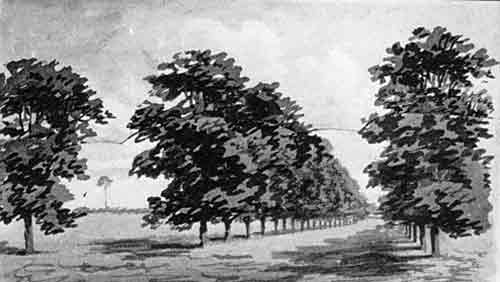
|
||||||||||
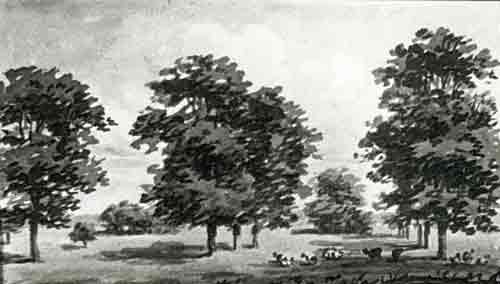 |
||||||||||
|
Of Lines |
||||||||||
| The great Avenue to the south I should advise to be left as it is, till the lease of the land be expired, which at present interferes with any plan of improvement. A line of hurdles might however be placed nearly in the direction marked E. in the map and the inclosure hedges should be removed: it should be remembered as a general rule in sinking fences, that to take the best advantage of those trees or bushes which grow in the hedge , and at the same time to obliterate every remembrance of the hedge, the new fence should be put in a totally different direction to the old one. The line of hurdles E will appear like a temporary division, and not a boundary: some of the things now growing in the hedges F. F. may be preserved to break the Lawn, and to all this the Farmer will make no objection because he gains the Land inclosed in the triangle E. and F. the same douceur may induce him to allow the fence to be sunk at G. to let in the distant country seen from the house in that direction. As the field H. cannot at present be united to the Lawn, a sunk fence or hurdles at I will in a great measure answer the same purpose because the hedge K. will appear from the house as one group of trees. The following sketch records the effect already produced by breaking the lines of trees which formally intersected each other in the View from the dining room. |
||||||||||
|
The following is Repton's sketch of the South Avenue as it was and below with his suggested alterations. |
||||||||||
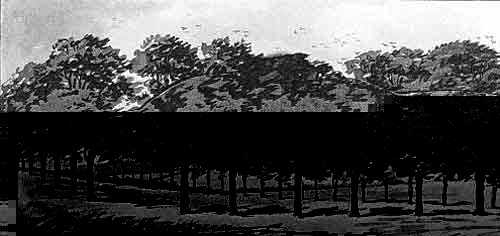
|
||||||||||
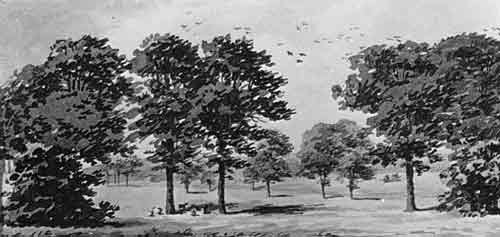 |
||||||||||
|
Walks |
||||||||||
| In a strong clay soil there is no object of comfort so necessary as good dry walks, the Approaches themselves at Hanslope should be made of such materials if possible as to become walks occasionally, and I consider the road and plantation B. B. as one of the most interesting that can be obtained; because it is not sufficient that a walk be pleasing in itself, it ought to be the line of communication to some interesting object; and I confess to the time when such advantage may be taken of the stream at the foot of the wood, as will make it one of the chief sources of delight to the possessors of Hanslope. It is not to be expected that any piece of water in that valley can be visible from the house, but in the approach from Gayhurst it may be made to appear so conspicuous an object, that the recollection of its being there will give fresh beauty to the view from the library, and the idea may perhaps be more strongly recalled by the appearance of a mast or sail of the pleasure boat which it will be proper to add to the scenery. I am not sufficiently master of the levels to say how far this water is practicable at small expense, but I can assert with confidence that it is possible, and that with such an accompaniment of wood it is perfectly advisable. |
||||||||||
|
Conclusion |
||||||||||
| This water would be made with better effect if some land lower down the stream could be united to the Hanslope property, and this I mention that no opportunity of obtaining it may be omitted. Then a very interesting and new line of walk might be conducted from the southern extremity of the water to return towards the house, in the meanwhile a pleasing walk near home may be obtained within the plantation I. And in many parts of the place the elegant spire of Hanslope may be beautifully introduced under various circumstances of foreground. |
||||||||||

|
||||||||||
|
The following is Repton's sketch of Hanslope Church. |
||||||||||

|
||||||||||
|
Hanslope Park today |
||||||||||
| Today there is very little to be seen of Repton's ideas for Hanslope Park, except for the plantation to hide the arable fields from the house. |
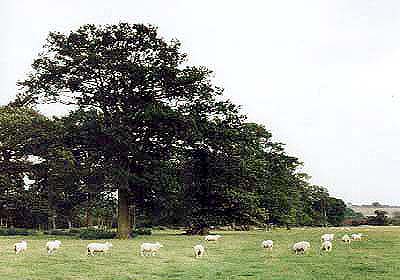
|
|||||||||
| The stream on which a boat was to be moored or a mast erected is rather overgrown today |
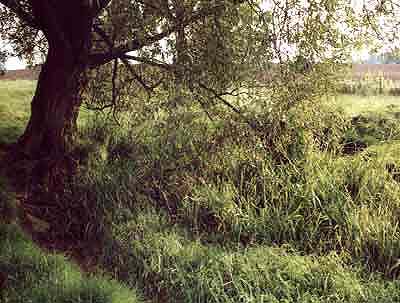
|
|||||||||
| Looking up to the wood there is no Keeper's Cottage or any evidence of it ever being built. The ploughed field in the foreground is hidden when looking in this direction from the house. |
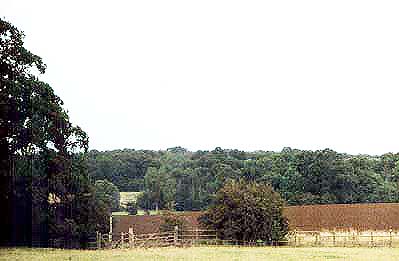
|
|||||||||
| Today the north and south avenues no longer exist, but the following map showing Hanslope Park circa 1900 shows the north and south avenues as they were when Repton produced his plans in 1792. From this evidence it seems that Edward Watts never implemented Repton's plan for the avenues. | ||||||||||
|
||||||||||